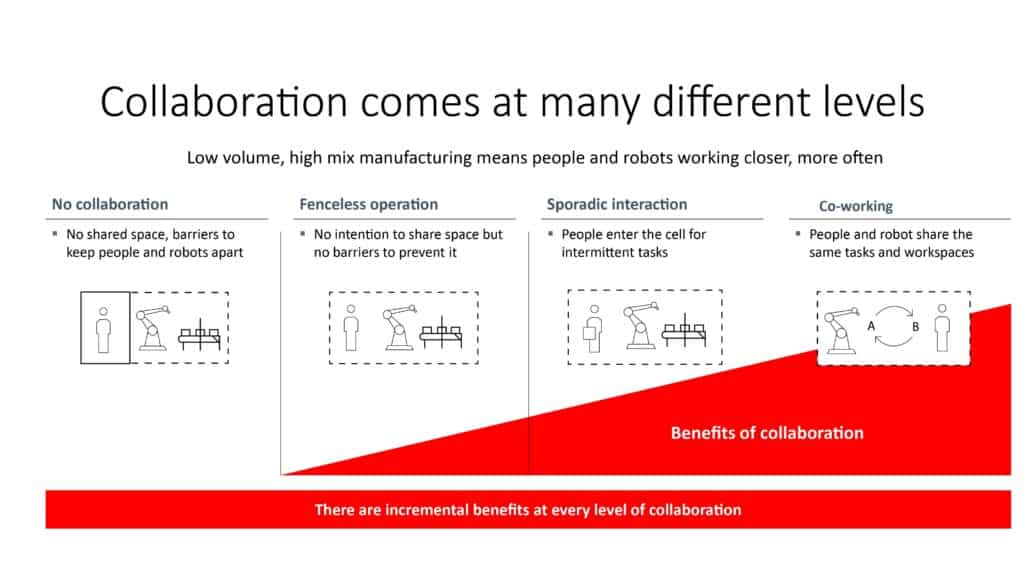What Are Cobots? The Truth About Robot-Human Collaboration
Cobots refer to ‘collaborative robots’, a huge trend in manufacturing right now. You may have heard about cobots, how easy and cheap they are, and how simple they are to manage on your own.
Here’s the thing: Good robots (and cobots) are not cheap and simple – and you wouldn’t want them to be. Collaborative robots and collaborative robot applications have changed the way that people are thinking about robotics—fundamentally. These types of systems, when engineered and integrated well, are productive and safe.
When people try to implement inexpensive, poorly-made versions as DIY solutions, things can get frustrating (and even dangerous) very quickly.
We’re here to help you avoid any problems. We’ll start by getting you the information you need to make an informed decision, beginning with a pretty fundamental definition.
What are cobots?
(And – is there a difference between ‘robot’ and ‘cobot’, really?)
Collaborative robots are a specific class of robot and surrounding integrated system that allow a robot and a human to work together. Often, in a well-designed collaborative robotics environment, a human and a robot can safely occupy close quarters. Robots can even work alongside humans cage-free. Right off the bat, you may see an issue with DIY cobots: You definitely don’t want to be working right next to a cage-free cobot that wasn’t installed and approved by expert integrators.
However, a cobot system does pose several benefits. We just have to integrate collaborative robotics safely. How can we accomplish this?
How do expert integrators make sure that a cobot system is safe?
When considering the question ‘what are cobots’ and brainstorming ways to implement them for practical use, we need to start by evaluating each application to see whether it can be collaborative. Cobots don’t automatically solve every manufacturing issue.
We also need to remember that implementing cobots can happen in logical, incremental steps. For example, consider the following levels of robot-person collaboration:
- Zero collaboration: Employees and robots do not share space. There exist barriers to ensure that this never happens.
- Fenceless collaboration: There may be no marked intention for employees and robots to share space—but there aren’t any barriers to make sure this doesn’t happen.
- Sporadic collaboration: People will enter the cell in which the robot works on an intermittent basis.
- Co-working: Robots and people will share the same space and work on the same tasks.

As you can see, there’s a type of collaboration perfect for every type of comfort level. Your integrator may assess your applications and recommend working your way up. This is one key difference between robot and cobot applications–this gradual approach towards a collaborative goal. Your integrator can also watch your systems carefully to ensure you’re not tackling more than you can handle.
Fortunately, you’ll see benefits even from introductory cobots, as long as they’re installed strategically and operated well.
What are cobots used for? How can companies safely leverage cobots?
As collaborative robotics is a newly-emerging technology that many are excited to leverage, there are stringent international standards that robotics manufacturers and integrators must work under in order to ensure safety at all times.
According to one of these international standards (ISO 10218 part 1 and part 2), there are four types of collaborative features that each use differing safety strategies. These include:
- A hand guide: A person operates the robot with direct mechanical input.
- A safety monitored stop: The robot pauses any motion if a person is in the shared workspace.
- Speed & Separation Monitoring: A safety laser keeps a robot away from a person, if there are no physical fences or barriers around.
- Power & Force Limiting: The robot has built-in power and force detection to keep it away from nearby humans.
Your integrator will make sure that your new cobot meets these requirements. This represents another key difference between robot and cobot engineering. Unlike robots, a well-built cobot should always have these strategic safeguards built-in.
What will an integrator consider when making a specific cobot recommendation for me?
In order to implement a robotics system that you can work with collaboratively, you need to look at the entire system. For example:
- You need to consider the End of Arm Tooling, or EOAT—the part of the robot that interacts with other components and parts.
- You need to look at the tools your robot may be using. Are those tools sharp? Can anything that the robot influences in its environment cause humans pain and suffering?
- You need to understand your cobot’s specifications. For example, PFL robots can only move at 250mm/sec during automatic operation. A PFL robot can move faster, but only if it has more comprehensive safety features. That way, the robot will be able to tell if there’s a human nearby and move at an appropriately safe speed.
At KC Robotics, we actually don’t like the term ‘collaborative robot.’ It’s too limiting! Only looking at the ways that a robot can be collaborative can cause you to miss out on the other ways that robotics can optimize your manufacturing process.
If you take one thing away from this post, it’s this lesson: A specific robot doesn’t make a system safe or collaborative. It’s how the whole system works together. Also, avoid DIY cobot installations; always consult with an integrator. You’ll save yourself time, money, and frustration…and you’ll avoid putting yourself and others at risk.
Wondering how to optimize your processes (and keep everyone safe)? Interested in the answer to ‘what are cobots used for’ in your own facility? KC Robotics can look at your system holistically and recommend strategic automation upgrades. Give us a call today to learn more!